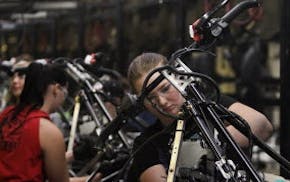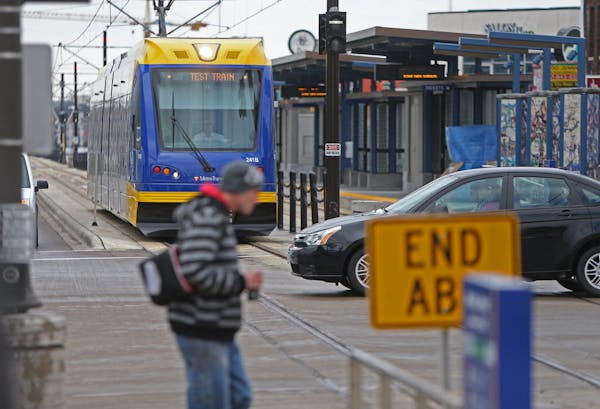After decades of planning, three years of construction, months of anticipation and some fine-tuning down the final stretch, the largest public works project in state history is just about ready to roll.
Come June 14, when public officials and dignitaries gather at St. Paul's Union Depot to cut the ribbon, the Twin Cities' newest light-rail transit route — the Green Line — will start up for real, connecting the downtowns of St. Paul and Minneapolis in a way that they've not been linked since the days of their old streetcar systems.
"This is about re-Twinning the Twin Cities," said Hennepin County Commissioner Peter McLaughlin, a longtime mass transit advocate. "We are trying to create a transportation system that is going to keep us economically competitive in this century. Connecting these cities is critically important to that."
Even as construction crews and transportation officials juggle last-minute tasks and test runs, the nearly $1 billion development, the most substantial transportation link between the downtowns since the building of I-94, is already making an impact: Officials are crediting the project with spurring $2.5 billion in commercial and housing development along its 11-mile route, with dozens of projects to come.
The Green Line also is expected to create $252 million in payroll by the time it is complete. But its influence extends well beyond buildings or jobs — some say it will transform the way we commute and the character of neighborhoods along the line for generations to come. Officials project that by 2030, annual ridership on the Green Line, which runs primarily along University Avenue, will surpass 10 million, matching the 2013 ridership total on the Blue Line, which runs from the Mall of America in Bloomington to downtown Minneapolis.
"Essentially, the light-rail system is changing the geography of the city. Some places are effectively becoming closer together," said David Lanegran, a geography professor at Macalester College. "And that's a big deal."
Opening Day parties
As opening day nears, construction crews, cops, train operators and transportation officials are busy with final preparations, ironing out the kinks and smoothing surfaces in time for the big rollout.
Despite some unexpected construction issues and downtown-to-downtown test runs of trains that have run slower — 20 minutes longer or more — than projected, transit officials are optimistic.
"We're going to be ready," said Vince Pellegrin, chief operating officer of Metro Transit. "Day One, we're going to run the schedule."
Some of the most frenetic work in recent weeks has taken place at several station stops, where community organizers plan daylong celebrations June 14.
At the Union Depot in downtown St. Paul, where the train's formal rollout will start with a 10 a.m. ribbon cutting, the day will be filled with live music, food and artwork from local sculptors and painters.
At Stadium Village on the University of Minnesota campus, Vikings and Gophers players, cheerleaders and mascots plan to mingle with the crowd. Restaurants also plan to offer food samples, and live music will be provided on the main stage.
And in the Midway neighborhood of St. Paul, the Hamline station is promoting a State Fair theme, featuring an international bazaar, a grandstand with shows, and food-on-a-stick treats.
At a recent Midway Area Chamber of Commerce meeting, Kari Canfield asked staff members to run through opening-day plans, which include some Como Zoo animals that will be on display.
The goal, she said, is to open the Green Line in a fun and exciting way.
"We want people to come to the area and remember it," she said. "And we want people to come back, again and again."
Trains, tracks and cracks
Public safety officials are checking off a list of their own.
Capt. Jim Franklin and the Metro Transit police are engaged in driver and pedestrian education before business groups and schools. It's sure to be an ongoing effort; on Friday, a motorist in St. Paul making a U-turn crashed into a Green Line test train. It was the third crash since training runs began earlier this year.
Twenty-two transit police have been added to the force to ensure the line is secure. Officers also will patrol designated beats along the route by foot, train, buses, bicycles and squad cars.
Each of the line's 18 train platforms also will have digital cameras monitored 24 hours a day at the system's Rail Control Center. Digital cameras will be in place on each rail car.
Most of the major construction work linking the downtowns is complete, but there have been some nagging issues.
A recent inspection of the road alongside the rail tracks found cracks in new concrete at several intersections — including Vandalia Street, Snelling Avenue and Lexington Parkway. That forced crews to again put up the orange construction barrels and detour signs that dominated University Avenue for several years as the line was built.
Walsh Construction is paying for the repairs, but the work has again slowed automobile traffic along University Avenue and inconvenienced local businesses, many of which suffered during the months of construction.
"We lost 50 percent of our business when they were building this thing," said Ron Boettcher, who has been slinging the roast beef hash at Bonnie's Cafe near Vandalia for a decade. "It had started coming back. Then they did this thing [crack repairs]."
The Vandalia repairs were completed last week and several other intersections were finished by Friday, the Metropolitan Council said. But snarls remain. Street resurfacing between Emerald and Rice streets only recently began and will take several weeks to complete.
Test trains, new signals
Even as construction continues, test trains are rumbling along the line from downtown St. Paul to Minneapolis and back. One hundred twenty train operators are being schooled, new signals are being synchronized with traffic lights, and a new Lowertown maintenance facility hums with life.
In all, 200 people have been hired for the Green Line, which follows a more urban route than the Blue. Downtown St. Paul also has some short blocks and tight curves, making it trickier to navigate than the Blue Line. Trains also will be no longer than three cars long, "because they would block an intersection," said Mark W. Fuhrmann, the Met Council's program director for New Starts Rail Projects.
That said, each three-car train can hold up to 550 passengers — significantly more than the 85 commuters who can squeeze into a bus on the soon-to-be-discontinued Route 50 that also follows University Avenue.
At the same time the trains are making final test runs, Metro Transit is changing bus service to give commuters easier access to the Green Line. For example, the 63 bus that runs mostly along Grand Avenue used to make its last stop at Summit Avenue and Finn Street. Now, that bus will head north on Cretin, pass Summit and eventually link with the Green Line. A total of 24 bus routes will be affected.
To merchants along University Avenue, the promise of more customers — and more business — is welcome.
For more months than he cares to count, Minh Nguyen watched as his customers were forced to navigate a makeshift dirt road to reach Trieu Chau, his 13-table Vietnamese restaurant at University and Mackubin. Still, he said, his business wasn't hurt as much as some. He has a small parking lot behind his place and a healthy list of regulars.
With the opening of the Green Line just weeks away, he admits to excitement as he tries to catch the eye of riders rolling past his restaurant for the first time.
"We all want to put our best foot forward," he said. "June 14th is a really big day."
James Walsh • 651-925-5041

Why you should donate clothing: It (probably) won't end up at the dump
4 are now charged in inside job armed robbery of Hopkins grocery store that netted $45K

Minnesota added thousands of jobs in March but worker shortage still an issue
Private prison van driver, accused of raping St. Paul woman he was transporting, gets 30 years for similar attacks

